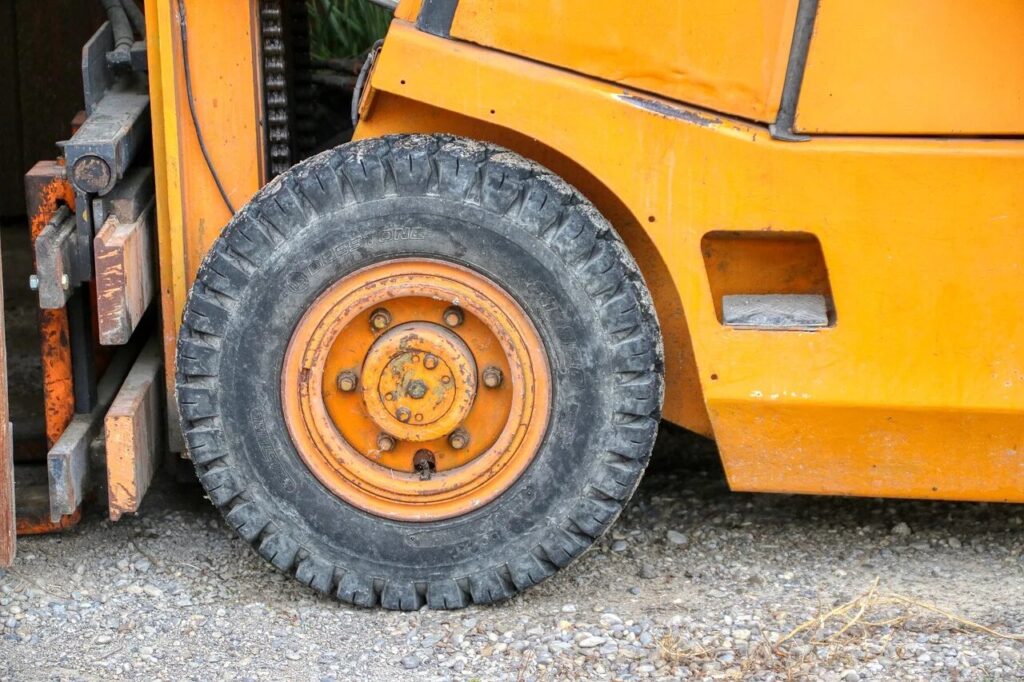Signs Your Forklift Tyres Need Changing

Operating a forklift should be an easy and straightforward task so long as adequate training is provided and employees hold a forklift licence. However, continuous operation over a lengthened period of time generates the onset of wear and tear – especially in the forklift truck tyres.
Businesses operating in the warehousing and storage units industry often rely on forklifts and forklift tyres. Without them, stock doesn’t get transferred from factory to warehouse, it doesn’t get loaded onto delivery trucks, your customers don’t receive their shipments and ultimately, you may not receive payment for your services.
It’s easy to concentrate on the engine and hydraulics upkeep and forget about the forklift tyres. It is often said that forklift tyres are the hardest working component on a forklift and therefore should not be neglected.
Forklift capacities range from about 3,000 lbs up to more than 70,000+ lbs (the lift rated capacity can be found on a forklift’s data plate). There are no suspension systems to help spread that weight meaning every single ounce of your load relies on a single ring of rubber tyre.
Unfortunately, forklift training does not necessarily cover all the important basics and fundamentals of forklift maintenance. See our article which discloses how regular forklift servicing should be carried out.
In this article, we will discuss:
- The possible signs of wear and tear on your forklift tyres
- The different types of tyres you can purchase for your forklift in today’s market.
- Final points for tyre maintenance
Signs Of Tyre Wear And Tear
Tyres Worn Over The Wear Line
Many forklift tyres have a wear line – often called the 50% wear line. When the wear of your tyres reaches that line, it’s time to get it replaced.
Chunking
If chunks of your tyres are falling off, it’s a good indication that you need to replace them.
Tearing/Cracking on The Tyres
Similar to chunking, if your tyres are tearing off in spots due to running over debris, they need to be replaced. Cracking tends to get overlooked in warehousing environments as such, It is vital that employees actively seek for cracks in forklift tyres.
Flat Spots
Your tyres should be round. If they are flat in any place it’s time to get them replaced
Skid Marks
If you’re seeing skid marks around your warehouse, it’s most likely that your forklift tyres are either over or under inflated.
Balding
Over or under inflating can not only ruin the tyres but, if it continues for long enough, it will damage the brakes as well. The brakes are affected because the bald tyres are causing the brakes to jam every time you try to stop.
Choose The Right Tyre For The Right Job
There are three types of forklift tyres. They are:
Cushioned Forklift Tyres
These tyres contain three layers of material: top (an anti-abrasive layer), middle (a soft, shock-absorbent layer) and a base (a rigid base to ensure tyres are fitted securely). Although cushion tyres wear slowly, they are easily damaged. It is important to look out for the warning signs as mentioned earlier in this article.
Pneumatic Forklift Tyres
Pneumatic tyres differ from cushion tyres as they are primarily used for outdoor work. Pneumatic tyres suit travelling at higher speeds over longer distances in a large yard area, but can be vulnerable to punctures.
Solid Forklift Tyres
Solid forklift tyres are perhaps the longest lasting of all three types of forklift tyres and can give many years of service. They offer less ride softening than cushion tyres and are best suited to operating on smooth surfaces both indoors and outdoors.
As solid forklift tyres become worn down they will give the forklift driver even less of a softer ride. After many years of continuous operation, the tyre can also become harder due to the rubber becoming perished. Solid forklift tyres will usually have a wear line to show when they have reached the end of their useful life cycle but may require changing prior to this if they are very old and perished.
Final Points For Tyre Maintenance
- Tyres are essential in softening the ride for your employee and the equipment. Tyres that are worn or low can cause significant safety hazards. One of the reasons for this is because tyre wear does not happen evenly, which creates instability. You can imagine the danger that arises when a load of roughly 3000lbs+ is angled on a forklift truck pallet where delicate stock may fall off leaving your business at a major loss in terms of wasted products.
- A damaged tyre will also create greater vibration, which results in driver fatigue consequently leaving the possibility for lower efficiency out of your employees and forklift use.
- Wear and tear of tyres can also increase fuel and maintenance costs. If tyres wear too far, performance and unnecessary damage to the machine can occur. Therefore, tyre maintenance is extremely important within the productivity of business and it is important to identify when it’s time your forklift tyres need to be replaced.
- When inspecting your tyres, make sure to check if there are any uneven signs of wear on each individual tyre. This includes both right and left front tyres and left and right rear tyres.
- Be sure to check your rims as well for any bending as they may need to be replaced as well. Tyre pressure on air-filled, pneumatic tyres should also be maintained at the recommended manufacture level.
